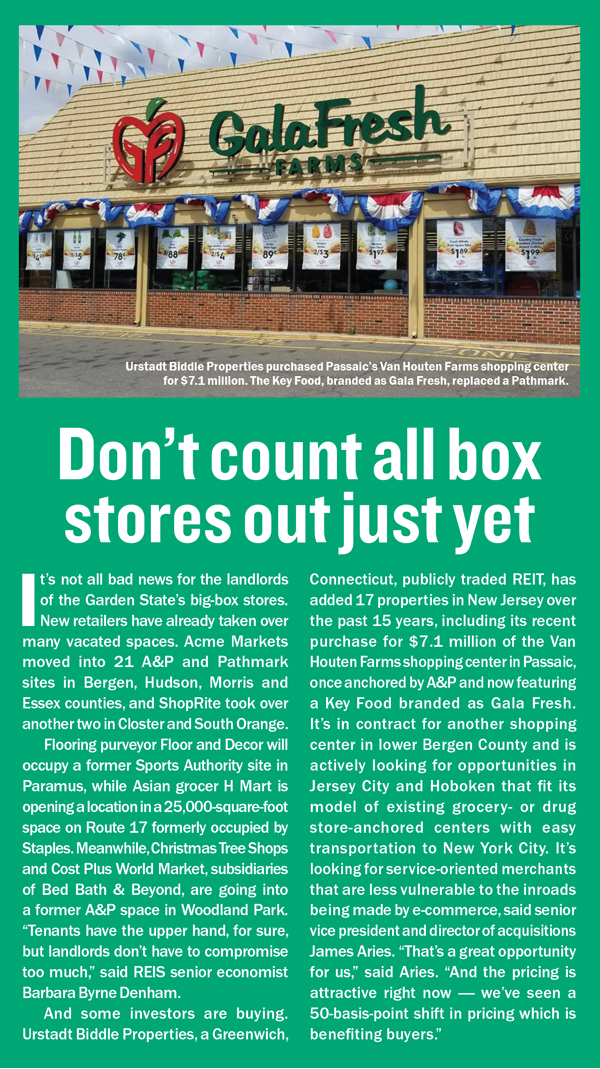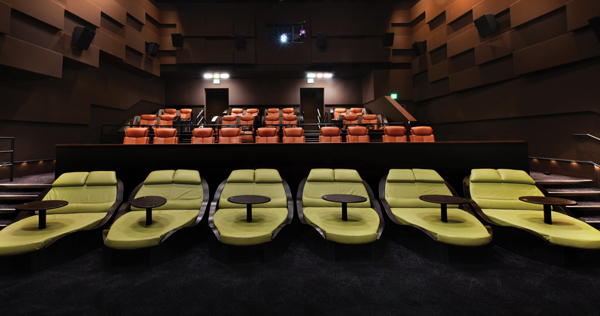The retail sector continues to reinvent itself in the well-to-do, densely populated northern counties of New Jersey. In a bid to counter the impact of e-commerce and big-box store closures, Garden State landlords and developers — following the national trend — are searching for nontraditional tenants including trampoline parks, fitness centers and dine-in movie theaters that can lure shoppers to reinvigorated shopping centers and high streets.
“Developers and existing shopping center owners are trying to find more reasons to bring people onto their property and are trying to find things that are going to make it more experiential,” said Steven Winters, a vice president of CBRE.
So far, the numbers indicate that the retail space is holding relatively steady in Jersey, but the spate of bankruptcies and closures means that many are counting on this trend toward nontraditional tenants to save the day.
During the first quarter of 2017, community shopping centers and strip malls in six of the state’s northern counties — Bergen, Essex, Hudson, Morris, Union and Passaic — had a vacancy rate of 8.1 percent. That’s flat compared to the previous three quarters, according to REIS. Asking and effective rents per square foot were almost flat, up only 0.3 percent, with multiyear leases helping to keep rents stable.
However, 22 retail corridors in Central and Northern New Jersey, including heavily trafficked highways such as Routes 4 and 17 in Paramus and Route 3 in Clifton, were faring a bit better, with retail vacancies edging downward to 6.7 percent compared to 7.2 percent last year, according to the Goldstein Group retail brokerage in Paramus.
While vacancies by big-box stores continue to affect the overall retail leasing market in the Garden State, there is continuing demand for small- to medium-sized spaces, said Goldstein president Chuck Lanyard.
“If anything, we are seeing absorption of space — not brisk absorption, but absorption, especially in good locations on highways,” said Lanyard.
That’s good news in light of the overwhelming doom-and-gloom predictions that e-commerce is consigning brick-and-mortar stores to obsolescence. At the end of 2016, Northern New Jersey — with 3.6 percent (803,000 square feet) of its total retail inventory vacated over the past two years — took ninth place in a REIS analysis of metro areas throughout the country most affected by closures of major retailers.
Indeed, two years ago, after declaring bankruptcy, A&P began to unload space, including 52 sites in New Jersey, many of them shopping center anchors. More recently, bankrupt retailers Sports Authority and Payless ShoeSource shut down locations in New Jersey, as did downsizing retailers Staples, Sears, JCPenney and Macy’s.
There are likely more vacancies to come. Goldstein’s Lanyard anticipates more closings, while REIS predicts the average vacancy rate in northern Jersey will rise to 8.7 percent between 2017 and 2021.
 Key to filling vacant spaces long-term is understanding how to adapt to changing consumer tastes, experts say. Overstimulated shoppers need new experiences. “Smart retailers have to provide more than SKU numbers on a shelf,” said Ron DeLuca, chairman of Oldbridge, N.J.-based retail real estate broker R.J. Brunelli & Co. “They have to make it fun and provide an engaging experience in the way they present materials and the way they allow consumers to shop.”
Key to filling vacant spaces long-term is understanding how to adapt to changing consumer tastes, experts say. Overstimulated shoppers need new experiences. “Smart retailers have to provide more than SKU numbers on a shelf,” said Ron DeLuca, chairman of Oldbridge, N.J.-based retail real estate broker R.J. Brunelli & Co. “They have to make it fun and provide an engaging experience in the way they present materials and the way they allow consumers to shop.”
Evidence of that type of innovation will soon be seen in Paramus’s Garden State Plaza, the biggest mall in New Jersey, which is remaking its food court into what it is calling an “urban bistro.” The space will feature a video gaming theater complete with high-definition screens and strobe lights where 30 people can play and compete against each other. Construction began this year.
Similarly, Hackensack’s Riverside Square is in the middle of a renovation that will bring, among other things, an AMC Dine-In Theater in mid-September. The theater will go into a space formerly occupied by luxury retailer Saks Fifth Avenue, which vacated the high-end shopping center at the end of 2014.
Last year, Saks also pulled out of the Mall at Short Hills, where it had been an anchor tenant since 1994. Now the department store is putting its money on the long-delayed and much-derided American Dream complex in the Meadowlands, where it has signed up for 132,000 square feet of retail space, according to the New York Business Journal. Developer Triple Five secured a $1.67 billion dollar loan in May to complete construction on the $5 billion American Dream project, now expected to open in 2019. The project is perhaps the apotheosis of the shop-and-play theme, with plans for a snow park, a water park and, in addition to Saks, other tony stores, including Hermès and Lord & Taylor.
At Willowbrook Mall in Wayne, Dave & Buster’s — a restaurant, sports bar and game arcade — is preparing to occupy the second floor of a former Sears store.
Later this year, Garden State Plaza in Paramus will be home to one of five Amazon brick-and-mortar stores coming to the state. The shopping experience promises something similar to what consumers find online: no cash and an app to display prices.
When a junior anchor space opens up, REIT Urstadt Biddle Properties, for one, always looks to go experiential, said James Aries, senior vice president and director of acquisitions at the company. “There was a perception that [nontraditional tenants] drained parking and that a customer going to a gym was not cross-shopping,” said Aries. “That’s not the case anymore. People are time-constrained, and retailers recognize that people are cross shopping.”
Fitness centers are seeing healthy growth in the midst of the retail downturn. Planet Fitness franchisee Anthony Falange, for one, operates seven locations in Morris and Passaic counties, has two more under construction and plans to open as many as five additional sites in North Jersey. Another fitness franchise, Club Pilates, has opened nine studios in the region since June of last year and has 12 more on the drawing board.
In the region’s more urban areas — Hoboken, Jersey City and Newark — new restaurants, bars and trendy retail continue their incursion into business districts and once-sedate downtowns. Redevelopment in downtown Newark is bringing in new retailers like Nike and Whole Foods and casual dining concepts such as Chipotle and Grabbagreen.
Elliott Ramos recently opened his first Wok to Walk franchise — a quick-service restaurant chain specializing in Asian food — on Broad Street in Newark’s central business district. He’s set to open another on busy Washington Street in Hoboken in mid-June and is looking at other potential locations. “There’s a lot of pedestrian traffic [on Washington Street], a night crowd and an upbeat feeling,” said Ramos. “The rents are okay, enough for us to say, ‘Yes, we’re going to do this deal.’”
 In Jersey City, over 600 small businesses have opened in the past three years, according to Mayor Steven Fulop in his State of the City address this year. They include numerous bars and restaurants and expanding mini-chains from across the Hudson River, like Barcade and Two Boots Pizzeria, which cater to the city’s growing population of millennials.
In Jersey City, over 600 small businesses have opened in the past three years, according to Mayor Steven Fulop in his State of the City address this year. They include numerous bars and restaurants and expanding mini-chains from across the Hudson River, like Barcade and Two Boots Pizzeria, which cater to the city’s growing population of millennials.
“You could live, dine and shop there and never have to leave Jersey City, much the way Brooklyn is,” said Curtis Nassau of Ripco Real Estate. “That’s the direction it’s going.”
Mixed-use developments, which often house residential and hotel space alongside office space and trendy shops and services for the residents, have been another magnet for new retail in Northern New Jersey.
Hudson Lights in Fort Lee, a 1 million-square-foot mixed-use development, opened the trendy iPic theater last fall. The chain offers pod seats, pillows and blankets along with food and drink in its screening rooms. S. Hekemian Group’s new Englewood South, a 40-acre site that was home to a GM plant, includes 100,000 square feet of retail, including tenants Panera Bread and Anthony’s Coal Fired Pizza along with 200,000 square feet of office space and 922 housing units.
In Jersey City, at least two mixed-use projects are in limbo. The Kushner Companies recently backed out of developing Bayfront, a contaminated site on the waterfront where the city is looking to have 600,000 square feet of retail space and 8,000 residential units.
At the same time, another Kushner project featuring a retail component and 1,467 apartments, the luxury development One Journal Square, is bogged down by a debate over tax breaks and by controversy related to a recent reference to Donald Trump son-in-law and advisor Jared Kushner made by Kushner’s sister as she pitched the project to Chinese investors.
Suburban downtowns are another story. Some, like Westfield, are usually bustling — although according to Downtown Westfield, 19 of that community’s retail sites are vacant and looking for tenants. Other main streets are stable, say real estate professionals, but for the most part they are not growing, hampered by limited parking, meager foot traffic and price competition from bigger players and online sellers. Englewood’s main drag, Palisade Avenue, for example, has empty storefronts, and officials are looking for ways to attract shoppers and diners.
“Main Street is suffering unless it’s called ‘cool street,’ catering to prepsters, hipsters and a millennial crowd with festival activities, pop-ups and food trucks,” said PricewaterhouseCoopers U.S. real estate leader Byron Carlock. “The cool street environment — Soho goes to Hoboken — does pretty well.”
